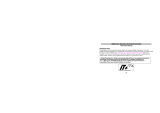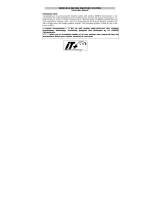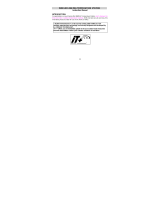Page is loading ...

30
WIRELESS 868 MHz WEATHER STATION
Instruction Manual
Cat. No. 35.1117.IT
Thank you for choosing this wireless weather station from TFA.
BEFORE YOU USE IT
Please be sure to read the instruction manual carefully.
This information will help you to familiarise yourself with your new device, learn all of its
functions and parts, find out important details about its first use and how to operate it, and get
advice in the event of faults.
Following the instruction manual for use will prevent damage to the device and loss of your
statutory rights arising from defects due to incorrect use.
We shall not be liable for any damage occurring as a result of not following these
instructions. Likewise, we take no responsibility for any incorrect readings and for
any consequences which may result from them.
Please take particular note of the safety advice!
Please look after this manual for future reference.

31
SCOPE OF SUPPLY:
Weather station (basic unit)
Outdoor transmitter
Instruction manual
FIELD OF OPERATION AND ALL OF THE BENEFITS OF YOUR NEW WEATHER
STATION AT A GLANCE
DCF-77 radio controlled time function with manual time setting options
DCF time reception ON/OFF
24 hour display
Calendar display
Time zone +/- 12 hours
Temperature display in degree Celsius (°C)
Indoor and outdor temperature with MIN/MAX records
Manual reset of MIN/MAX records
3 weather forecast icons with weather tendency indicator
Wireless transmission at 868 MHz
Signal reception interval at 4 seconds
Low battery indicators
Wall mounting or table standing (detachable stand)

32
FOR YOUR SAFETY:
The product is exclusively intended for the field of application described above. The
product should only be used as described within these instructions.
Unauthorised repairs, modifications or changes to the product are prohibited.
Caution!
Risk of injury:
Keep the instruments and the batteries out of reach of children.
Batteries must not be thrown into the fire, short-circuited, taken apart or recharged.
Risk of explosion!
Batteries contain harmful acids. Low batteries should be changed as soon as possible
to prevent damage caused by a leaking battery. Never use a combination of old and
new batteries together or batteries of different types. Wear chemical-resistant
protective gloves and glasses when handling leaked batteries.
! Important information on product safety!
Do not expose the instrument to extreme temperatures, vibration or shock.

33
The outdoor transmitter is protected against splash water, but is not watertight. Choose
a shady and dry position for the transmitter.
ELEMENTS
The weather station
LCD
display
Function
buttons
Hanging hole
Battery
compartment
cover
Detachable
stand

34
The outdoor temperature transmitter
Remote transmission of outdoor temperature to weather
station by 868 MHz signals
Splash water proof casing
Wall mounting and table-standing
Mounting at a sheltered place. Avoid direct rain and
sunshine
INSTALL AND REPLACE BATTERIES IN THE TEMPERATURE TRANSMITTER
The temperature transmitter uses 2 x AAA, IEC LR3, 1.5V batteries. To install and replace
the batteries, please follow the steps below:

35
1. Remove the battery compartment cover at the back of the
transmitter.
2. Insert the batteries, observing the correct polarity (see marking).
3. Replace the battery compartment cover on the unit.
INSTALL AND REPLACE BATTERIES IN THE WEATHER STATION
The weather station uses 2 x AA, IEC LR6, 1.5V batteries. To
install and replace the batteries, please follow the steps
below:
1. Lift up the battery compartment cover.
2. Insert batteries observing the correct polarity (see
marking).
3. Replace compartment cover.

36
Battery replacement
Replace the batteries when the battery symbol of the weather station appears above
the indoor temperature.
When the batteries of the transmitter are used up, the low battery icon appears above
the outdoor temperature display.
Note:
In the event of changing batteries in any of the units, all units need to be reset by following
the setting up procedures. This is because a security code is assigned by the temperature
transmitter at start-up and this code must be received and stored by the weather station in
the first 3 minutes of power being supplied to it.
SETTING UP:
Note: This weather station receives only one outdoor transmitter.
1. First, insert the batteries into the outdoor transmitter. (see “Install and replace
batteries in the temperature transmitter“).
2. Within 30 seconds, insert the batteries into the weather station (see “Install and
replace batteries in the weather station”). Once the batteries are in place, all
segments of the LCD will light up briefly. Then the time (default 0:00), the weather icon

37
and the indoor temperature will be displayed. If these are not displayed after 1 minute,
remove the batteries and wait for at least 1 minute before reinserting them.
3. After inserting the batteries, the weather station will start receiving data from the
outdoor transmitter. The outdoor temperature and the signal reception icon should then
be displayed on the weather station. If this does not happen after 3 minutes, the
batteries will need to be removed from both units and reset from step 1.
4. In order to ensure successful 868 MHz transmission, this should under good conditions
be a distance no more than 100 meters between the final position of the weather
station and the transmitter (see notes on “Mounting” and “868 MHz Reception”).
5. Once the outdoor temperature has been received and displayed on the weather
station, the DCF time (radio controlled time) code reception is automatically started.
This takes typically between 3-5 minutes in good conditions.
NOTE FOR RADIO-CONTROLLED TIME DCF:
The time base for the radio-controlled time is a caesium atomic clock operated by the
Physikalisch Technische Bundesanstalt Braunschweig. It has a time deviation of less than
one second in one million years. The time is coded and transmitted from Mainflingen near
Frankfurt via frequency signal DCF-77 (77.5 kHz) and has a transmitting range of
approximately 1,500 km. Your radio-controlled clock receives this signal and converts it to
show the precise time. Changeover from summer time or winter time is automatic. The

38
quality of the reception depends mainly on the geographic location. Normally there should be
no reception problems within a 1,500 km radius around Frankfurt.
DCF reception is done twice daily at 02:00 and 03:00 am. If the reception is not successful at
03:00 am, then the next reception takes place the next hour and so on until 06:00am, or until
the reception is successful. If the reception is not successful at 06:00 am, then the next
attempt will take place the next day at 02:00 am.
If the tower icon flashes, but does not set the time or the DCF tower does not appear at all,
then please take note of the following:
Recommended distance to any interfering sources like computer monitors or TV sets is
a minimum of 1.5 - 2 meters.
Within ferro-concrete rooms (basements, superstructures), the received signal is
naturally weakened. In extreme cases, please place the unit close to a window and/ or
point its front or back towards the Frankfurt transmitter.
During nighttime, the atmospheric disturbances are usually less severe and reception
is possible in most cases. A single daily reception is adequate to keep the accuracy
deviation below 1 second.

39
FUNCTION BUTTONS:
Weather station:
The weather station has four easy to use function buttons.
SET button
Press and hold to enter manual setting modes: time zone, manual time, calendar and
DCF time reception ON/OFF
+ button
To change any values in manual set modes
INDOOR/RESET button
To display the MIN/MAX indoor temperature records
SET button
INDOOR/RESET button
+ button
OUTDOOR
button

40
Press and hold to reset all indoor and outdoor MIN/MAX temperature records at the
same time
OUTDOOR button
To display the MIN/MAX outdoor temperature records
LCD SCREEN:
Indoor
temperature in °C
Outdoor
temperature in °C
Weather tendency
indicator
Time reception icon
(for DCF time)
Low battery indicator
(weather station)
MAX icon
Time
Weather forecast icon
Outdoor reception
signal icon *
Low battery indicator (transmitter)
MIN icon

41
* When the outdoor signal is successfully received by the weather station, the icon will be
switched on (if it is not successful, the icon will not be shown in LCD). So user can easily see
whether the last reception was successful (icon on) or not (icon off).
MANUAL SETTINGS:
The following manual settings can be done in the setting mode:
Time zone
Manual time
Calendar (year, month and day)
Time reception DCF ON/OFF
Press and hold the SET button for about 5 seconds to advance to the setting mode:
TIME ZONE SETTING:
The time zone default is “0” hour. To set a different time zone:
1. The current time zone value starts flashing.
2. Use the + button to set the time zone. The range runs from 0, -1, -2…-12, 12, 11, 10…
2, 1, 0, in consecutive 1-hour intervals.
Time zone (flashing)

42
3. Confirm with the SET button and enter the Manual time setting
MANUAL TIME SETTING
In case the weather station is not able to detect the radio-controlled time (DCF time) signal
(due to disturbances, transmitting distance, etc.), the time can be manually set. The clock will
then work as a normal quartz clock.
To set the clock:
1. The hour digits start flashing in the time display section.
2. Use the + button to adjust the hours and then press SET button to go to the minute
setting.
3. The minute will be flashing. Press the + button to adjust the minutes.
4. Confirm with the SET button and enter the Calendar setting
Note:
The unit will still try to receive the signal despite a manual setting. When the signal is
received, the manually set time will automatically be replaced by the received time. During
Hour (flashing)
Minute

43
reception attempts, the DCF tower icon will flash. If reception has been unsuccessful, the
DCF tower icon will not appear but reception will still be attempted.
CALENDAR SETTING
The date default of the weather station is 1. 1. of the year 2011 after initial set-up. Once the
radio-controlled time signals are received, the date is automatically updated. However, if the
signals are not received, the date can also be set manually.
1. The year is flashing. Use the + button to set the year required. The range runs from
2011 to 2039.
2. Press the SET button to confirm and enter month setting.
3. The month a digit will be flashing. Use the + button to change value.
4. Press the SET button to confirm and enter day setting
5. The day digit is flashing. Use the + button to change value.
6. Press SET button to confirm and enter the Time reception ON/OFF setting
Year (flashing)
Month (flashing)
Day (flashing)

44
“On” (flashing)
Reception icon
(flashing)
TIME RECEPTION ON/OFF SETTING
In area where reception of the radio-controlled time (DCF time) is not possible, the time
reception function can be turned OFF. The clock will then work as a normal quartz clock.
(Default setting is ON).
1. “On” is flashing on the LCD.
2. Use the + button to turn OFF the time reception function if necessary.
3. Confirm with the SET button and exit the setting mode.
Note:
If the time reception function is turned OFF manually, the clock will not attempt any reception
of the radio-controlled time (DCF time) as long as the time reception function is activated
again (On). The time reception icon and the DCF icon will not be displayed on the LCD.
WEATHER FORECAST AND TENDENCY
THE WEATHER FORECASTING ICONS
There are 3 weather icons in the top section of LCD which can be displayed in any of the
following combinations:

45
For every sudden or significant change in the atmospheric pressure, the weather icons will
update accordingly to represent the change in weather. If the icons do not change, then it
means either the atmospheric pressure has not changed or the change has been too slow for
the weather station to register. However, if the icon displayed is a sun or raining cloud, there
will be no change of icon if the weather gets any better (with sunny icon) or worse (with rainy
icon) since the icons are already at their extremes.
The icons displayed forecasts the weather in terms of getting better or worse and not
necessarily sunny or rainy as each icon indicates. For example, if the current weather is
cloudy and the rainy icon is displayed, it does not mean that the product is faulty because it is
not raining. It simply means that the atmospheric pressure has dropped and the weather is
expected to get worse but not necessarily rainy.
Note:
After setting up the weather station the readings for weather forecasts should be disregarded
for the next 12-24 hours. This will allow sufficient time for the weather station to collect
Rainy
Cloudy with sunny intervals
Sunny

46
atmospheric pressure data at a constant altitude and therefore result in a more accurate
forecast.
Common to weather forecasting, absolute accuracy cannot be guaranteed. The weather
forecasting feature is estimated to have an accuracy level of about 75% due to the varying
areas the weather station has been designed for use. In areas that experience sudden
changes in weather (for example from sunny to rain), the weather station will be more
accurate compared to use in areas where the weather is stagnant most of the time (for
example mostly sunny).
If the weather station is moved to another location significantly higher or lower than its initial
standing point (for example from the ground floor to the upper floors of a house), discard the
weather forecast for the next 12-24 hours. By doing this, the weather station will not mistake
the new location as being a possible change in atmospheric pressure when really it is due to
the slight change of altitude.
WEATHER TENDENCY INDICATOR
Working together with the weather icons is the weather tendency indicators (located on the
right sides of the weather icons). When the indicator points upwards, it means that the
atmospheric pressure is increasing and the weather is expected to improve, but when
indicator points downwards, the atmospheric pressure is dropping and the weather is
expected to become worse.

47
Taking this into account, one can see how the weather has changed and is expected to
change. For example, if the indicator is pointing downwards together with cloud and sun
icons, then the last noticeable change in the weather was when it was sunny (the sun icon
only). Therefore, the next change in the weather will be cloud with rain icons since the
indicator is pointing downwards.
Note:
Once the weather tendency indicator has registered a change in atmospheric pressure, it will
remain permanently visualized on the LCD.
INDOOR TEMPERATURE AND MIN/MAX RECORDS
The current indoor temperature is displayed on the third section of the LCD.
Press and release the INDOOR/RESET button repeatedly, the current indoor temperature
will alternate between the minimum, maximum temperature recordings and the current value.
MIN indoor
temperature
record
MIN icon
(flashing)
MAX indoor
temperature
record
MAX icon
(flashing)

48
OUTDOOR TEMPERATURE AND MIN/MAX RECORDS
The current outdoor temperature is displayed on the last section of the LCD.
Press and release the OUTDOOR button repeatedly, the current outdoor temperature will
alternate between the minimum, maximum temperature recordings and the current value.
RESETTING INDOOR AND OUTDDOR MIN/MAX TEMPERATURE RECORDS
In normal display mode, press and hold the INDOOR/RESET button for 3 seconds to reset in
one time ALL indoor and outdoor minimum/maximum records to current values.
ABOUT THE OUTDOOR TRANSMITTER
The outdoor temperature is measured and transmitted every 4 seconds.
The range of the temperature transmitter may be affected by the temperature. At cold
temperatures the transmitting distance may be decreased. Please keep this in mind when
placing the transmitter.
MIN outdoor
temperature
MIN icon
(flashing)
MAX outdoor
temperature
MAX icon
(flashing)

49
868 MHz RECEPTION CHECK
The weather station should receive the temperature data within 3 minutes after set-up. If the
temperature data is not received 3 minutes after setting up (not successfully continuously,
the outdoor display shows “- - -” ), please check the following points:
1. The distance of the weather station or transmitter should be at least 1.5 to 2 meters
away from any interfering sources such as computer monitors or TV sets.
2. Avoid positioning the weather station onto or in the immediate proximity of metal
window frames.
3. Using other electrical products such as headphones or speakers operating on the
same signal frequency (868MHz) may prevent correct signal transmission and
reception.
4. Neighbours using electrical devices operating on the 868MHz signal frequency can
also cause interference.
Note:
When the 868MHz signal is received correctly, do not re-open the battery cover of either the
temperature transmitter or weather station, as the batteries may spring free from the contacts
and force a false reset. Should this happen accidentally then reset all units (see Setting up
above) otherwise transmission problems may occur.
The transmission range is about 100 m from the temperature transmitter to the weather
station (in open space). However, this depends on the surrounding environment and
interference levels. If no reception is possible despite the observation of these factors, all
/






